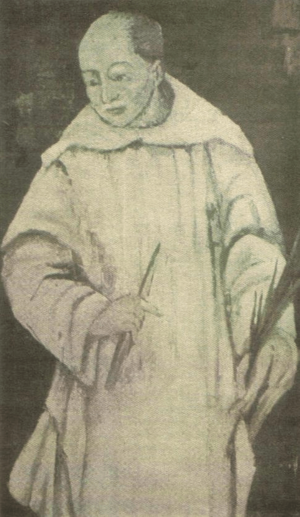Augustine Webster facts for kids
Quick facts for kids SaintAugustine Webster O. Cart. |
|
|---|---|
 |
|
| Carthusian Martyr | |
| Died | 4 May 1535 Tyburn, London, England |
| Honored in | Roman Catholic Church |
| Beatified | 29 December 1886 by Pope Leo XIII |
| Canonized | 25 October 1970 by Pope Paul VI |
| Feast | 4 May (individual) 25 October (collectively with Forty Martyrs of England and Wales) |
| Attributes | martyr's palm, knife, Carthusian habit |
Saint Augustine Webster was a brave English monk who lived a long time ago. He was part of a special group of monks called the Carthusians. He was the leader, or "prior," of a monastery in Epworth, England. He is remembered as a martyr because he died for his beliefs on May 4, 1535.
Contents
Who Were the Carthusians?
The Carthusians were a very respected group of monks. They lived in quiet monasteries called "Charterhouses." These places were like hermitages, where monks lived simple, strict lives. They focused on prayer and devotion. At the time of Saint Augustine Webster, there were ten such monasteries in England.
Augustine Webster's Life
Augustine Webster studied at Cambridge University. After his studies, he became a monk at the Charterhouse of Sheen. In 1531, he became the prior of Our Lady of Melwood. This was a Carthusian monastery in Epworth, England.
In 1535, England was going through big changes. King Henry VIII wanted to be the head of the Church in England. This was a new idea called "royal supremacy." It meant the King, not the Pope, would lead the Church.
Augustine Webster traveled to London. He went with another prior named Robert Lawrence. They met with John Houghton, the prior of the London Charterhouse. They wanted to discuss how Carthusians should respond to the King's new rules.
The monks were loyal to the King in many ways. But they felt they could not accept the King as the head of the Church. This went against their deep religious beliefs. They decided to speak to Thomas Cromwell, the King's main advisor. They hoped to be excused from this new rule. However, Cromwell did not agree with them.
Standing for His Beliefs
Around April 1535, Augustine Webster was arrested. He was put in the Tower of London. This happened because he refused to take the Oath of Supremacy. This oath would have made him promise that the King was the head of the Church.
Other monks, including John Houghton and Robert Lawrence, were also arrested. They were joined by Richard Reynolds, another religious man. All four were accused of treason for not accepting the King's new role.
Their trial took place on April 28. They said they were "not guilty" of treason. The jury at first did not want to find them guilty. But after pressure from Thomas Cromwell, the jury changed its mind.
On May 4, 1535, Augustine Webster and the others were executed at Tyburn. They died because they stood firm in their faith.
Honoring Saint Augustine Webster
Augustine Webster is one of the Forty Martyrs of England and Wales. These are people who died for their Catholic faith during this time. Pope Paul VI officially recognized him as a saint in 1970.
You can find stained glass windows honoring him in several churches:
- Holy Souls Church in Scunthorpe, North Lincolnshire
- Our Lady and the English Martyrs, Hills Road, Cambridge
- St Etheldreda's Church in Ely Place
- St Mary's Roman Catholic Church, Bridge Gate, Derby
- Roman Catholic Parish of St. Mary and St. Augustine Webster, Barton-upon-Humber
A school in North Lincolnshire, St. Augustine Webster Catholic Voluntary Academy, is named after him. The Roman Catholic Parish of St. Mary and St. Augustine Webster also carries his name.
See also

